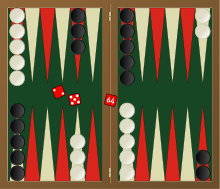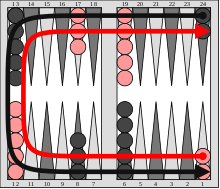
WFH Personal Strategy Dos and Don’ts
November 10, 2020
Is Your Business Strategy Inoculated?
November 10, 2020The Strategy Game While Sheltering In Place

With no commute, other than upstairs to our shared office, no errands to run, no meetings after work, and an earlier than normal dinner, my family’s nights have opened up a bit. Yes, you can binge-watch all kinds of things on Netflix, but after the 6th day, you start looking for something for your brain to do that’s a little more engaging than passive movie watching.
So, in response to our boredom, my husband pulled out the Backgammon game.
If you’ve never played it, backgammon is one of the oldest board games in the world and is believed to have originated in Persia. A two-player game, each player has a home board and checkers scattered in different spots around a larger board. The objective of the game is to return all your checkers to your home board and, once there, to ‘bear off’ or remove your checkers faster than your opponent who is trying to do the same thing. Movement during the game is based on rolls of the dice.


There are a variety of different ways to accomplish this and it’s the right combination of both strategy (where will you move) and luck (what the dice give you) that determines the winner. As a strategy planner, this game of strategy (and luck), should be mine to own. I am a facilitator for my company MPOWR, a SaaS company that makes strategy execution management (SEM) software, and have been working in my field for over 25 years. Piece of cake, right?
Wrong. I lose almost every time to my husband, an engineer.
Pathetic!
Not happy with my performance, I began to look at the reasons why. I saw a pattern in the strategy of backgammon that wasn’t unlike ways to approach real-world strategy which is also a function of both skill and chance – especially during these challenging times. Here are four of the most frequently employed strategies with their pros and cons.
-
The Aggressive Strategy
If a player leaves one of their checkers on its own their opponent – with the right role – can hit that checker and force them to go all the way back to a vulnerable position on their opposing home board. This strategy can be useful at the right time. Stop the advances in the competition. Put the competition on the defensive. Keep them reacting instead of being on the offensive. A good strategy to take at specific times. But overusing it puts the enemy in droves on your home board. Good for tactical hits. A strategy that is best followed by opportunistically.
-
The Wishful Thinking Strategy
This involves hoping for a particular roll in order to execute your plan. While highly effective when it happens, relying on things outside your control, such as luck and chance, to be able to implement your plan is probably not a first-line approach to long term strategy. It’s something you should be ready to adopt should it happen but not something on which you base success over the long-term.
-
The Carefully Crafted and Detailed Plan Strategy
From the first roll of the dice, this strategy is what I’m going to do. I have a plan and I will stick to it despite what my opponent does, despite what my dice give me, despite what my opponent’s dice are. This kind of focus is good in order to not get derailed by small distractions. There’s nothing more powerful than focus in a larger organization. Taken too far, however, extreme focus doesn’t allow you to shift and pivot based on internal or external changes. If your feet are too cemented into the concrete, opportunities could pass you by or problems could get the best of you.
Free Strategic Readiness Assessment
-
The Change With the Wind Strategy
This is the player that only responds to outside forces: each roll of the dice, each new checker movement of the competition, each individual new position the checkers are in. This strategy is highly adaptable, highly responsive, and frequently changing. It thrives on speed and innovation. In organizations, it is the non-strategy strategy. It is the “we follow what’s next and fast”. In the right circumstances, this works. In other circumstances strategy that only belongs to the shifts of external forces is bound to lack an overall direction eventually.
The most important lesson about the strategy you choose in both backgammon and business is that each of these types has its place. What’s most important is that you are able to shift and adjust when a particular ‘sub-strategy’ fits the situation you are in. Choose to have a detailed plan while being wary and willing to respond to competitive pressures. If something happens that is a stroke of luck, be flexible enough to grab the opportunity. Finally, rigidity in today’s ever-changing environment will not be as strong as a strategy that moves fast when a decision is made.
We at MPOWR call this strategic improvisation. Know who you are, know who you serve, know what you value, and then be ready to deliver on all of those things as your circumstances dictate. Have a planned strategy that is flexible enough to move when you need it and focused enough to be unifying.
We are living in uncertain times. Let your strategy be your guide.



